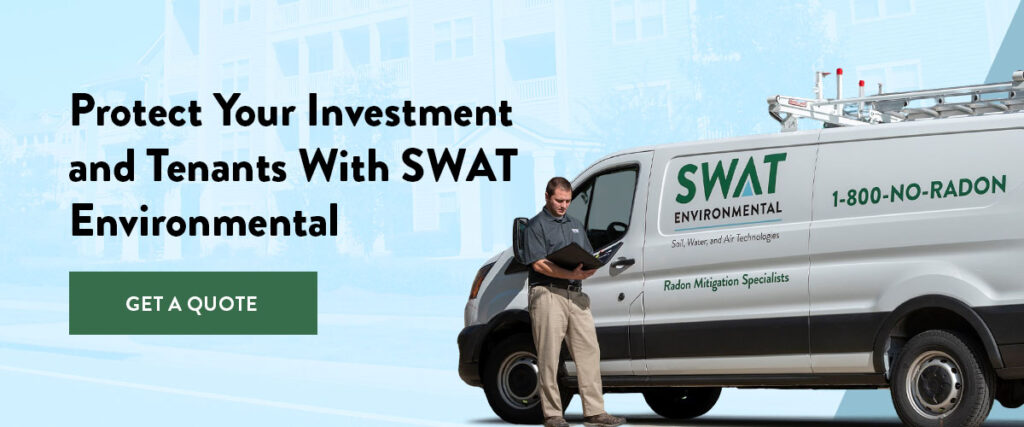You can’t see it or smell it, but radon is quietly seeping into millions of buildings across the country. This invisible threat affects approximately one in 15 homes in the U.S., and for property owners, it’s not just a health concern — it’s a financial and legal one, too.
Whether you manage a high-rise office, a multifamily property or a local school, radon exposure can compromise the safety of everyone inside. It can also expose your business to costly liabilities, compliance issues and property value risks. Understanding how it forms and how to mitigate it helps protect your building and the people in it.
What Is Radon and How Does It Enter Buildings?
Radon is a colorless, odorless radioactive gas created when uranium in soil and rock naturally breaks down. As this gas moves upward through the ground, it seeps through cracks in foundations, gaps around service pipes or even porous concrete floors.
Once inside, radon becomes trapped, accumulating in basements, lower floors or any enclosed space with poor ventilation. Since radon emits ionizing radiation as it decays, prolonged exposure can damage lung tissue. Health authorities, including the U.S. Environmental Protection Agency (EPA), warn that radon is the nation’s second leading cause of lung cancer, responsible for thousands of deaths each year.
Concentrations can vary dramatically between properties depending on soil composition, construction type and ventilation patterns. The only way to determine if your building has elevated radon levels is to conduct a test.
Why Radon Is a Commercial Property Concern
For homeowners, radon is a serious health issue. For business owners and property managers, it’s also a liability issue. Under duty-of-care and workplace safety standards, employers and landlords are expected to maintain safe indoor environments. If elevated radon levels go unaddressed, tenants or employees could claim negligence, especially if they experience health effects linked to prolonged exposure.
Beyond liability, unmitigated radon can devalue commercial real estate. Prospective buyers or investors often request environmental testing during due diligence. A failed radon report, or the absence of one, can delay transactions, reduce offers or complicate financing.
Addressing radon proactively helps maintain occupant safety and strengthens your property’s long-term value.
Navigating Radon Rules and Regulations
The rules around radon can be nuanced. Knowing which ones apply to your property helps you plan testing, documentation and mitigation with confidence.
Are Commercial Radon Tests Required?
While the EPA provides national guidance on radon, specific testing and mitigation requirements often depend on state and local laws. Commercial property owners should understand the rules that apply to their building type, location and funding source.
Many states and municipalities have established their own regulations, particularly for schools, daycares and government-financed housing.
Does OSHA Cover Radon?
The Occupational Safety and Health Administration (OSHA) recognizes radon as a potential workplace hazard. The OSHA exposure limit for adult employees is 100 pCi/L, averaged over a 40-hour workweek. Under the General Duty Clause, employers must provide a safe working environment, and elevated radon levels could fall under that obligation. That means if employees are working in areas where radon levels exceed safe limits, employers have a legal and ethical responsibility to address it.
In practical terms, employers may be required to conduct periodic testing, install a mitigation system, post caution signs and provide training to employees.
Do HUD-Financed Multifamily Properties Require Testing?
HUD-financed multifamily housing has strict radon testing and mitigation requirements. Every ground-contact unit and a representative sample of upper floors must be tested by certified professionals. If results exceed the EPA action level of 4.0 pCi/L, mitigation must be completed before closing or occupancy is permitted.
Does General Liability Insurance Cover Radon Claims? What About Pollution Liability?
Most general liability (GL) policies exclude pollutants, and radon often falls within that category. That means the property owner may be required to cover the cost of radon mitigation. Some insurers do offer specialized pollution liability coverage, which can fill that gap. Reviewing your coverage with an environmental risk specialist is the best way to confirm whether your policy covers radon-related claims.
Assessing Your Property’s Radon Risk
Every property is different, but certain building types and conditions make some commercial spaces more susceptible to radon than others. Understanding your building’s risk helps prioritize testing and mitigation.
Which Property Types Are Most at Risk for Radon?
Certain buildings are naturally more prone to radon accumulation. Here are some property types that should be considered high-priority for regular radon testing and monitoring:
- Multifamily housing and apartment complexes: Ground-level and basement units often sit directly on or below the soil, where radon infiltration is most likely to occur.
- Schools and child care centers: Children and staff spend extended hours indoors each day, increasing long-term exposure risks if radon levels are elevated.
- Office and government buildings: Structures with basements, slab-on-grade foundations or sealed windows can trap radon and restrict ventilation.
- Industrial and warehouse spaces: Large floor areas, minimal air circulation and direct ground contact make these buildings susceptible to radon buildup.
- Healthcare facilities and nursing homes: Patients and residents may be more vulnerable to health impacts from radiation exposure, making radon mitigation a critical safety measure.

Geography also plays a role. Properties located in EPA “Zone 1” areas — regions with predicted average indoor levels above 4.0 pCi/L — are at the highest risk, though elevated levels can occur anywhere.
How Often Should You Test for Radon?
Regular testing helps ensure your building’s mitigation systems remain effective and your occupants stay safe. Experts recommend testing:
- Upon purchase or occupancy of a new property.
- Every two to five years, as part of ongoing environmental maintenance.
- After major renovations, HVAC upgrades or foundation work that could alter airflow or building pressure.
The Commercial Testing and Mitigation Process
Radon is highly manageable with professional mitigation. The key is working with qualified specialists who understand the complexity of large structures and multi-unit systems.
Professional Radon Testing
The right testing approach provides accuracy, compliance and confidence in your results:
- Finding a certified testing professional: Commercial radon testing should be performed by certified testing experts who follow proper placement, retrieval, EPA and AARST protocols for valid results that meet recognized standards.
- The commercial testing process: Depending on the building size and layout, multiple testing monitors are placed throughout ground-contact areas, basements and occupied spaces. Tests may be short-term to get an initial snapshot or long-term to measure seasonal variations.
- Understanding your test results: The EPA’s action level for radon is 4.0 pCi/L. Readings at or above this threshold indicate elevated radon concentrations that warrant mitigation.
SWAT Environmental doesn’t provide radon testing, but we can help guide you in the process of getting it completed.
Mitigation System Design and Installation
When radon levels exceed recommended limits, mitigation systems are designed to redirect radon gas safely away from the building. The most common method, sub-slab depressurization, uses a fan-driven vent system to create negative pressure beneath the foundation, pulling radon out before it can enter occupied areas.
For commercial structures, systems may require multiple suction points, vertical stacks or specialized piping to handle large footprints and variable construction materials. Leaders in radon mitigation, like SWAT Environmental, custom-design each system to meet structural, regulatory and aesthetic needs.
What Are the Typical Testing and Mitigation Costs?
Costs depend on several factors, including:
- Building size and layout.
- Foundation type and accessibility.
- Number of suction points required.
- Vent routing complexity.

Protect Your Investment and Tenants With SWAT Environmental
For more than three decades, SWAT Environmental has specialized in commercial and multifamily radon mitigation systems nationwide. Our teams are experts in navigating local compliance rules, designing custom large-scale solutions and delivering rapid results with minimal business disruption.
As the nation’s largest radon mitigation company, we provide documentation and compliance support, scalable solutions for complex structures and ongoing system monitoring and maintenance options.
Contact SWAT Environmental for a mitigation quote today.

